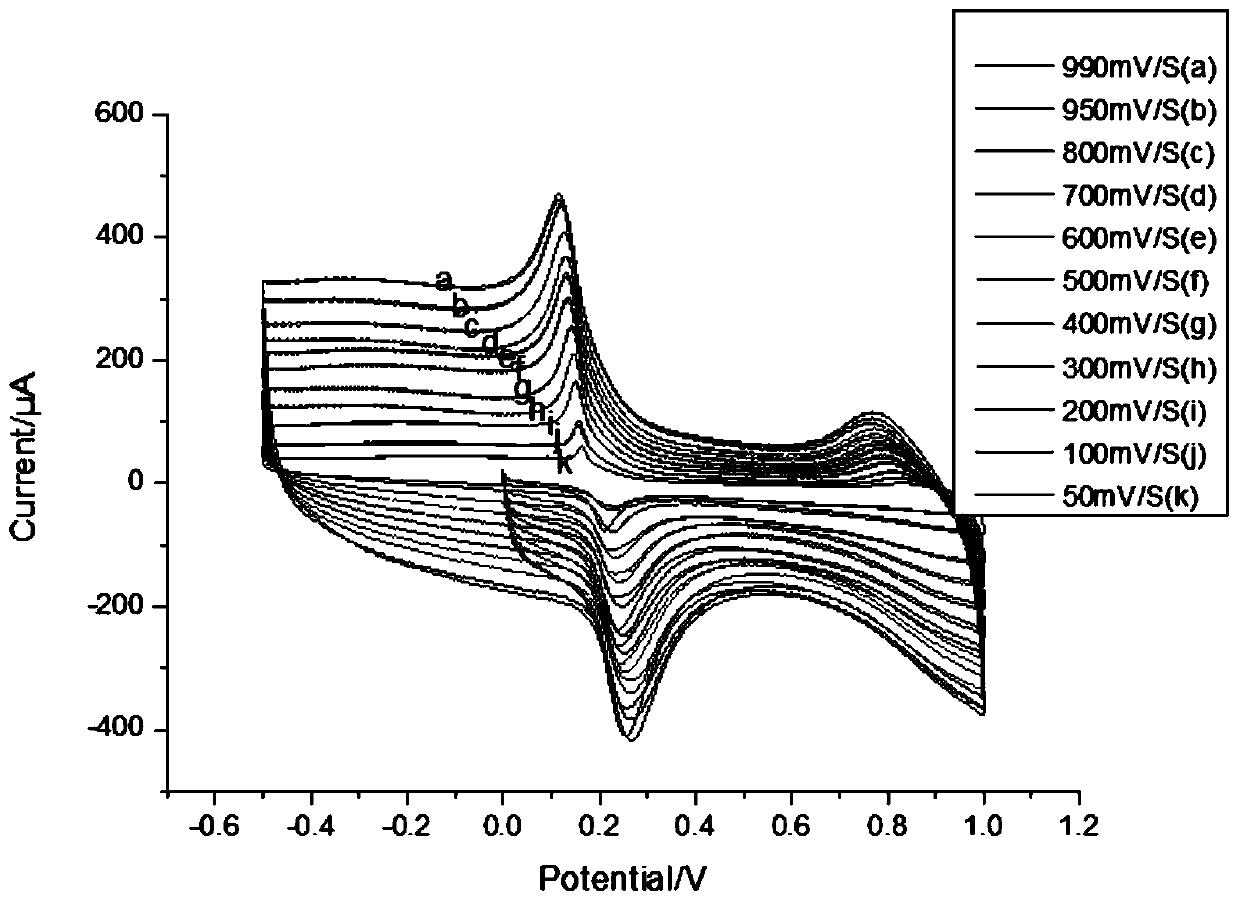Preparation method and application of a kind of immune biosensor
A biosensor, Prussian blue technology, used in instruments, scientific instruments, measuring devices, etc., can solve the problems of time-consuming, difficult to perform on-site detection, and inconvenient to carry detection equipment, and achieve a simple and efficient preparation method and excellent sensitivity. Effect
- Summary
- Abstract
- Description
- Claims
- Application Information
AI Technical Summary
Problems solved by technology
Method used
Image
Examples
Embodiment 1
[0032] Embodiment 1: Preparation of immune biosensor
[0033] A method for preparing an immune biosensor, comprising the following process steps:
[0034] 1) Use a pipette gun to take 10 μL of graphene oxide dispersion solution with a concentration of 1 mg / mL and drop-coat it on the surface of the electrode substrate, dry it at room temperature, and then place it in a 0.1 mol / L potassium chloride solution, and use cyclic voltammetry to The scan rate of 100mV / s scans 20 times in the potential range of -1.5 ~ 0.5V, and the reduced graphene modified electrode is obtained;
[0035] 2) Insert the reduced graphene-modified electrode obtained in step 1) into a Prussian blue solution with a concentration of 0.1mol / L, and scan 60 laps within the potential range of 0-1.0V by cyclic voltammetry at a scan rate of 50mV / s, Form a Prussian blue deposition layer to obtain a Prussian blue / graphene modified electrode;
[0036] 3) Apply the porcine epidemic diarrhea virus monoclonal antibody d...
Embodiment 2
[0040]Embodiment 2: Determination of detection conditions of immune biosensor
[0041] (1) Effects of different pH on its detection of porcine epidemic diarrhea virus
[0042] The antibody-coated immunobiosensors were tested by cyclic voltammetry in the bottom solution of pH6.4, pH6.7, pH7.0, pH7.5 and pH8.0, and the test results were as follows: figure 1 As shown, the bottom solution with pH 7.0 is one of the optimal conditions for the immunobiosensor to detect porcine epidemic diarrhea virus with the same scanning speed and the same potential range.
[0043] (2) Effects of different base solutions on the detection of porcine epidemic diarrhea virus
[0044] The antibody-coated immunobiosensors were respectively placed in distilled water and the bottom solution constant in PBS, and tested by cyclic voltammetry. The test results are as follows: figure 2 As shown, the same scanning speed and the same potential range are obtained, and the bottom solution constant volume of PB...
Embodiment 3
[0049] Example 3: Performance testing of immune biosensors
[0050] (1) Stability
[0051] The immunosensor was stored in a refrigerator at 4°C, and retested after 30 days, and the current response was recorded. Compared with the initial signal, it had good consistency.
[0052] (2) specificity
[0053] The immunosensor is used to detect positive contrast samples containing PRRVS, CSFV, and FMDV, and the virus in the samples is detected by cyclic voltammetry, and the detection results are as follows: Figure 5 As shown, it can be seen that the current of the comparative sample drops significantly, which is obviously different from the detection result of porcine epidemic diarrhea virus.
PUM
| Property | Measurement | Unit |
|---|---|---|
| particle diameter | aaaaa | aaaaa |
Abstract
Description
Claims
Application Information
 Login to View More
Login to View More - R&D
- Intellectual Property
- Life Sciences
- Materials
- Tech Scout
- Unparalleled Data Quality
- Higher Quality Content
- 60% Fewer Hallucinations
Browse by: Latest US Patents, China's latest patents, Technical Efficacy Thesaurus, Application Domain, Technology Topic, Popular Technical Reports.
© 2025 PatSnap. All rights reserved.Legal|Privacy policy|Modern Slavery Act Transparency Statement|Sitemap|About US| Contact US: help@patsnap.com



